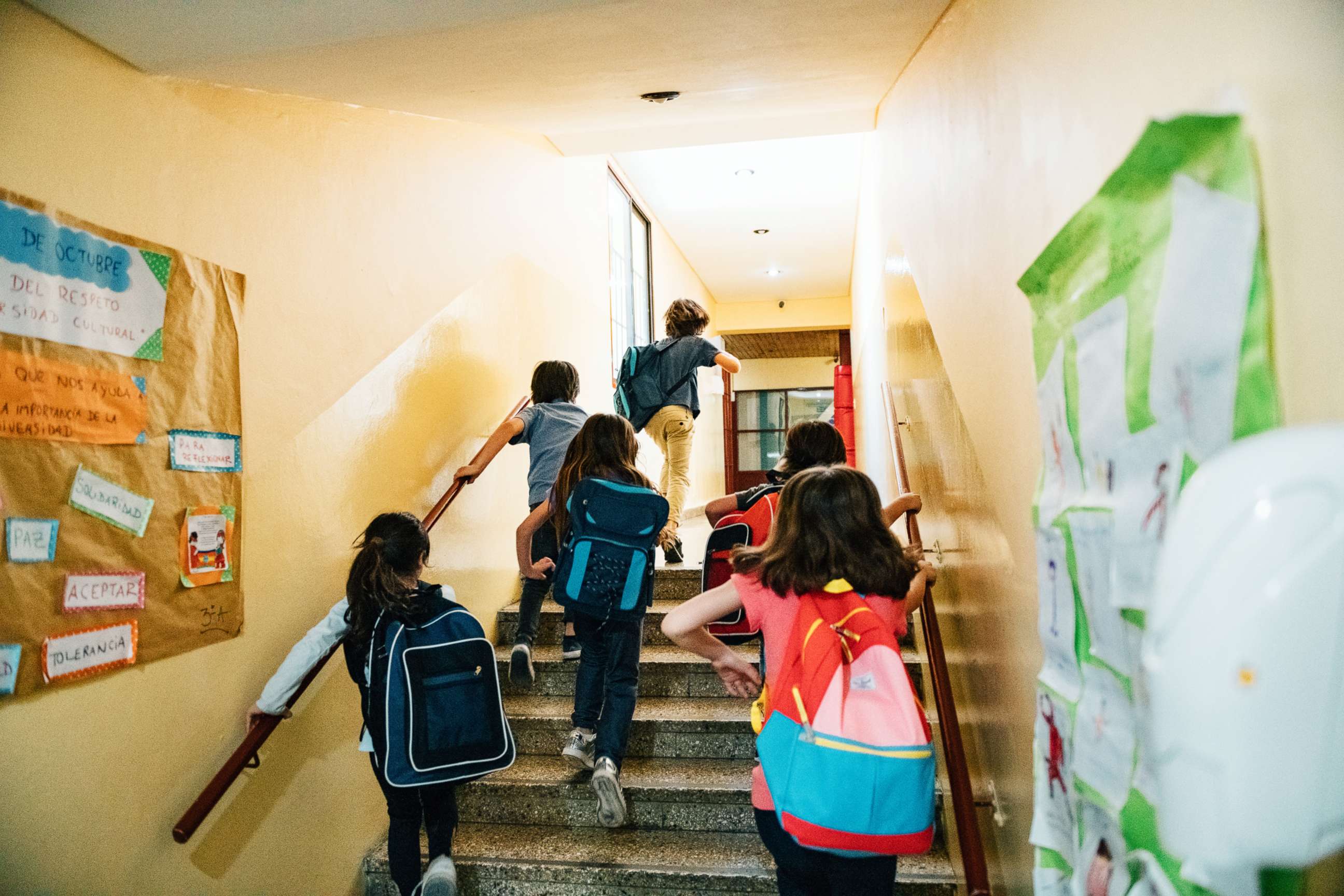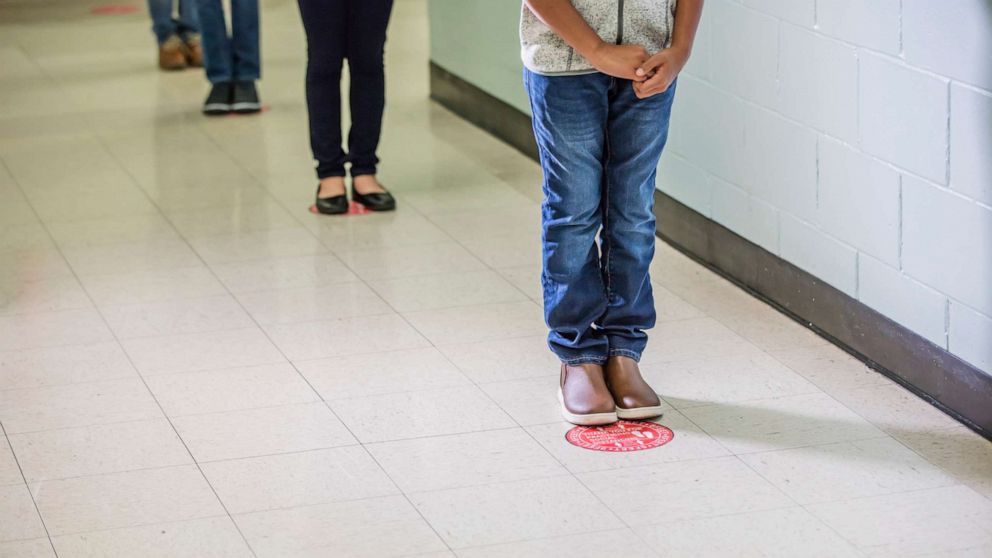How 1 Chicago school district got kids back in the classroom during COVID-19
Around 70% of students are going in person, thanks to a saliva testing system.
As the novel coronavirus pandemic divided communities and kept many kids out of the classroom, one school district in the Chicago suburbs found a way to keep its doors open: regularly testing students using its own system.
"We have been open every single day since the first day of school," Kelli Kalata, the district nurse, told ABC News.
In addition to a hybrid schedule, masks and social distancing measures, LaGrange School District 102 has offered once-a-week saliva tests to students and staff as another mitigation strategy. Although it is not an FDA-authorized test, individuals involved with the project at the school district say the goal isn't to diagnose cases, but rather alert the school to a potential case. School officials say the RT-LAMP test, which can detect infections caused by RNA viruses, has helped identify asymptomatic and pre-symptomatic cases of COVID-19. ABC News did not independently verify the accuracy of this test.
The school system's success in staying open raises questions about whether other districts could be doing the same if they had the resources.

"It is not an overstatement to say that a relatively sophisticated high school student in their high school lab could develop" certain tests, Health and Human Services Secretary Alex Azar said in a statement Friday, addressing lessons learned from the pandemic.
Among the just over 3,000 students at La Grange School District 102, about 30% are attending class remotely, while the other 70% are in the classroom every day. Half of the students attend in-person classes in the morning, and the other half in the afternoon, the superintendent explained.
Elementary school students are sent home with a test kit on a specific day and return with it the next morning, placing their kit in a bin for collection. The district collects junior high students' saliva on campus just outside the school door after they are released for the day, Kalata explained. She noted that students who are attending school remotely are also offered the option to partake in the testing.
"Our screening was set up to randomly catch staff and students who are asymptomatic -- and that's exactly what it's done," Kalata said.
School District 102 Superintendent Kyle Schumacher told ABC News the district worked on developing a saliva testing "surveillance system."
"All of our students who sign up for this -- and there's about 82% of our district signs up to do this -- get tested every week," he said.
But Schumacher attributed some of the success to good fortune, as the school board member who helped spearhead the effort, Edward Campbell, is also a virologist at Loyola University Chicago.
After spending the last two decades focused on the biology of the HIV infection, Campbell, who has three children enrolled at District 102, said, like many of his colleagues, he felt he could be helpful when it came to COVID-19. The opportunity came over the summer, he said, when school administrators and teachers were looking for a way to reopen schools in a safe way.
"Everyone, including the teachers, wants to have students in school, because they realize that's better for children, but they also are concerned about their safety," Campbell told ABC News. "And if everyone wants to have in-person learning in a safe environment, it really just kind of came down to an opportunity to change the definition of safe, so that everyone could agree on it."
Campbell said he developed a test for the district based on surveillance system models his colleagues in Colorado and Wisconsin had developed.

"Really what you need is the recipe and somebody who is familiar with lab work, and if you have those things, you can do it," he said.
Campbell said he was able to put something together just before school started.
"In the middle of August, you know, they were like, 'OK, let's try to do this,' and we had to pull it all together in two weeks to try to get it going. But once the board gave me permission, at that point, I was going to die trying. Or make it work. And I didn't die," Campbell said, adding that those two weeks were "probably the most intense of my life."
The district converted its science center -- students visited for field trips prior to the pandemic and it's still home a parrot named Murphy -- into a lab that now processes tests from students in three districts.
With help from fellow Loyola faculty members, who gave Campbell items he needed for the lab, they got the test working just two days before they were set to start collecting saliva from District 102 participants.
"It took a series of miracles and, you know, good people to help get us where we got," he said. "It was kind of like the virology version of 'Apollo 13.' But we landed it."
Although there were hiccups along the way, Kalata, the district nurse, described the process now as "an efficient, well-oiled machine." She said that remaining open throughout the school year is something to "be really proud of."
Campbell explained that, like a PCR test, the RT-LAMP test has "primers" that "amplify regions of the COVID genome if it's there," which is what his team monitors for.
If an individual shows "clinical significance" the lab manager gets in touch with Kalata, who looks the person up in their system and contacts their household. Although the school treats "clinical significance" as a positive and requires the student to isolate and any siblings to quarantine, they are not diagnosing individuals, instead encouraging them to get in touch with their doctor for next steps, like getting a PCR test.
Both Kalata and Schumacher questioned whether this kind of system could have been rolled out more broadly and note how it could have benefitted other schools that have struggled to figure out how to return to school safely.
"This is working. We figured this out. And I think the frustrating part is knowing that could this have been figured out on a grander scale for others," Schumacher said, adding he wished the state or federal government could have offered something similar, as many other schools have reached out to his district asking to participate.
After realizing there was a demand for this kind of surveillance screening in schools, Campbell created a company, called Safeguard Surveillance, that he said is now working with around 30 schools or school districts, but he jokes that he hopes he is out of business in the next six months. "I'll be here as long as people need us, but I sure hope that I'm not doing this nine months from now," he said.
Since schools shuttered in March at the beginning of the pandemic and communities grappled with the risks involved in returning to the classroom, the Trump administration has pushed to open schools despite pushback from educators and unions who argued there was no broader strategy to ensure safety. Although educators in some places have begun receiving the vaccine, offering some hope that a return to normalcy is within reach, it's still uncertain when exactly that might be.
"We seem to have all these guidelines that we have to have in place to have schools open. OK, thank you for giving us those guidelines, but then what kind of help are you giving us to get the doors open?" Kalata said. "So that's why I so appreciate Dr. Campbell and Dr. Schumacher for thinking outside the box."




